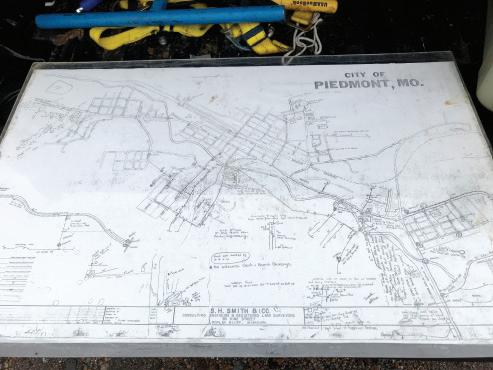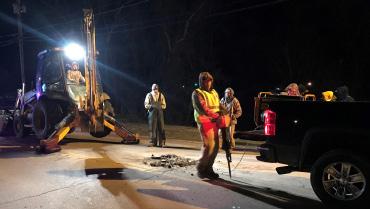
9 minute read
10 Days without Water: A Case Study of a Town in Crisis
Brad Rayburn, MRWA Circuit Rider
MRWA assisted the City of Piedmont with restoring water after they unexpectantly lost water to approximately 1,500 customers on March 13, 2021. Those customers included the school, a nursing home, and numerous businesses.
Advertisement
The town of Piedmont has a creek that twists throughout the entire town with numerous creek crossings. The suspect for a leak was one of those crossings. Piedmont has three towers in town that supply water to their customers and two of those towers were completely empty. The towers are filled from their surface water treatment plant that is located at the southern end of town. Unfortunately, it took ten grueling days to completely restore service to everyone because of multiple issues that came up during this event.
March 13 – That morning, Piedmont Water Specialist Brandon Radford began receiving calls that continued throughout the day from customers informing him they had no water. Radford and the city water department considered that a water leak had caused the issue and thought they had a good idea where it was located. The maintenance department worked tirelessly throughout the night into the following day to expose the 6” main that was in a creek crossing. They assumed the main was broken, but after further inspection discovered this was not the case. All other probable locations were checked, but they could not find the source of the leak. MRWA Emergency Response Coordinator Eric Fuchs was contacted by SEMA following Piedmont’s request for bottled water, and on Monday morning MRWA Circuit Rider Joe Anstine arrived on-site.
March 15-16- Anstine worked all day and into the evening searching for the leak, and later that evening found a leak, which we will call Leak #1. The following morning Leak #1, a leak on a small service line serving a meter, was dug up and repaired and ruled not to be the primary leak. Anstine was joined by MRWA Circuit Riders Jeff Lee and Brad Rayburn to assist with leak location. The Circuit Riders searched most of the day by exercising valves to see if water could be heard going through the valves with acoustic leak detection equipment. By afternoon, the Circuit Riders had located Leak #2 on a 6” water main which appeared large enough to prevent the towers from filling. Leak #2 was repaired that evening but did not resolve the tower situation.
March 17- The Circuit Riders were joined by MRWA Source Water Protection Specialist Eric Fuchs and MRWA Circuit Rider Eric Thurman to assist in the search. That day they located 2 additional leaks (#’s 3 & 4): the first isolated by a valve and the other repaired. Unfortunately, neither helped restore water service to those 1,500 customers. Typically, a leak this large does not take this long to locate, but this was far from typical.
MRWA Circuit Riders Jeff Lee and Joe Anstine exercise valves for leak detection.
March 18 (Day 4) – Not resolving the situation after four days was frustrating. The onsite MRWA staff had not only been searching for the cause for 3 days, but they had also been enduring continual thunderstorms, flood warnings, and falling temperatures. By that evening, they had eliminated the leak being in almost every location near the creek. During this time, MRWA used a Radio Detect line locator to locate most of the water mains in town. This equipment located an 8” main that went through the town running underneath State Highway 34. A breakthrough moment was when Circuit Riders heard MRWA Circuit Rider Eric Thurman water going through an additionally located main line valve on goes underground to assist with leak that main. This was a breakthrough because according to the detection (Topside view of Hwy 34). map, this main ended at a pump station used to pump water MRWA Circuit Rider into the north tower that was more than 2/3 mile away from the main line valve. MRWA Resource Eric Thurman’s view. Conservation Circuit Rider Wayne Roderman arrived on-site to assist with leak location. To perform flow testing, the Circuit Riders recommended the city water department dig up the main located underneath the state highway in various locations. The highway had to be shut down and by 3:00 am the 8” main had been exposed and flow tested in 8 different locations. Each location tested showed a flow of 350 gallons per minute (gpm). MRWA staff was in disbelief that the leak had not been found on that line and decided to meet at the pump station at 7:00 am to analyze MRWA Circuit Rider Joe Anstine and city water department work to expose under-highway main. the system data they had collected up to this point. Being first to arrive, Anstine and Lee shut off a valve near the pump station which caused water to begin filling the clear well. The pumps were used to pump water from the clear well to the north tower. It was determined that the valve Anstine shut off had a massive leak after it, but no one knew the valve’s purpose until MRWA had exposed the water main in main street. This valve shut off an old water line that had previously supplied water to a subdivision next to the pump station. March 19- MRWA and the city maintenance department confirmed that the leak had been located and isolated from the water system by closing that valve. With this leak confirmed and isolated, the city opened the valves and restored water to its residents. That evening, Radford notified Rayburn that the two towers were still not filling. Rayburn presumed they had overlooked some valves needing to be reopened. The following morning, he checked all the valves that had been closed and confirmed they were all open. Also, the Holmes tower was filling so that indicated the north tower was the only tower not filling. Because the north tower had to be filled by the pump station, Rayburn was sure it had to be a pump issue. It (continued on page 45)




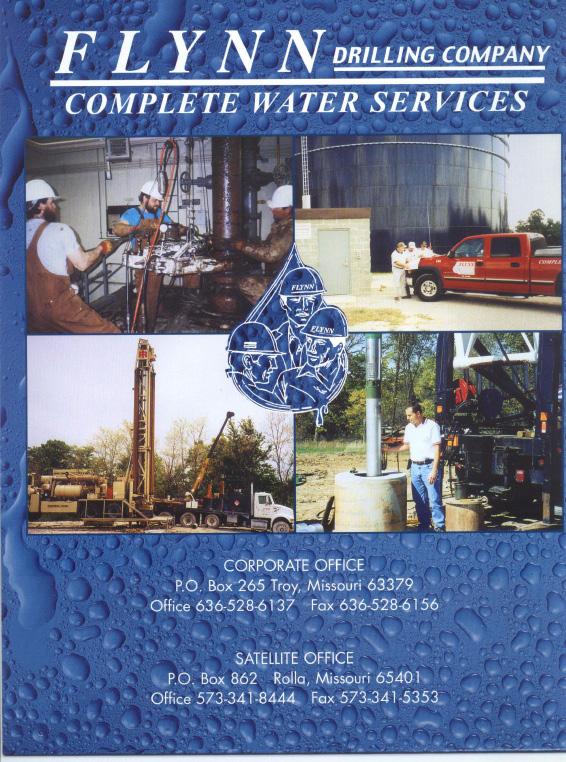
(continued from page 42) was discovered that the pump was airlocked and once the air was bled off, it resumed pumping from the clear well. Later, Radford contacted Rayburn to let him know that the north tower was still not filling. Rayburn returned and determined that a leak had to be on the main leaving the pump station.
March 20- Rayburn and the city water department exposed the entire 200 feet of water main from the pump station to the creek. No leak was detected, so Rayburn suspected that the leak was in the creek. An 8” valve was installed on the line so that it could be confirmed that the leak was in the creek. Following valve installation, Rayburn listened to the valve but to his surprise, he could not hear water flowing through the line to the creek. Eric Fuchs had joined Rayburn and was opening valves on the opposite side of the creek. One of the valves that Fuchs opened caused water to flow backwards to the pump station at 350 gpm. So, this showed that the water leak had to be in the 200 feet of line between the creek and pump station. Unfortunately, it was midnight, and everyone had been working since early that morning, so finding the problem would have to wait until the following day.
March 21- Wayne Roderman joined Fuchs and Rayburn to assist with locating the issue. The prior day it was discovered that only one water main was tied into the pump station line between the creek and pump station. That line was installed to increase pressure to the school and went through a creek and field. Rayburn had closed that valve on numerous occasions but could not detect water flow through the valve. The valve was left closed, but when Roderman listened to the valve that morning with his X-mic he could hear water flowing through the line. At that moment, Rayburn realized that the leak had been located. The reason water could not be heard flowing through the valve sooner was because up to that point, water wasn’t allowed to flow backwards through the pump line from the Holmes tower. Water was not in the Holmes tower until March 20 and the 8” valve that was installed the night before allowed MRWA to understand how water flowed from the Holmes tower to the pump station. Rayburn had only thought he had that valve closed, but since no resistance was on the valve, it only seemed that the valve was closed.
A short brisk walk to the creek where the line crossed revealed the leak was in the creek. This line had been considered on a couple of different occasions for a leak, but without flow through the pipe the leak could not be detected. That valve was closed and the leak was isolated. The pump was turned on and immediately customers north of the water tower began getting water for the first time in 10 days, including the nursing home and high school.
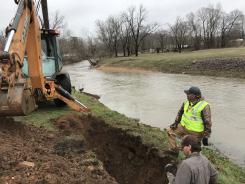
The “Team” exposes the main to the creek.
6 Ears are better than 2. MRWA Circuit Riders listen for leaks.
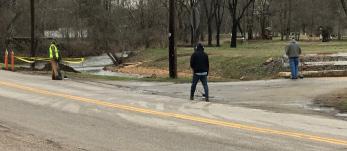




(continued from page 45) During their time in Piedmont, MRWA field staff worked long hours locating water lines and valves just to understand how the distribution system supplied water to its three towers. The city water department worked side-by-side with MRWA to expose the water main and unearth numerous valves that had been hidden for years under dirt and asphalt. The city had never dealt with anything like this before and no one in the water department knew exactly how the distribution system flowed. The only map available was a basic, rudimentary drawing of the water lines made in the 1960’s with penciled in remarks that were faded and difficult to translate.
This situation of a small-Missouri town in crisis serves as a great example of just how important a tool that accurate and up-to-date maps can be. It also serves as a reminder, the importance of cross-training personnel to understand how all the components in a system work together to provide your customers, Quality on Tap.
If your system finds itself in crisis, give us a call. For more information on MRWA GIS Mapping, contact MRWA at (573) 657-5533.
MRWA Circuit Rider Brad Rayburn and others grab lunch on-the-go.
